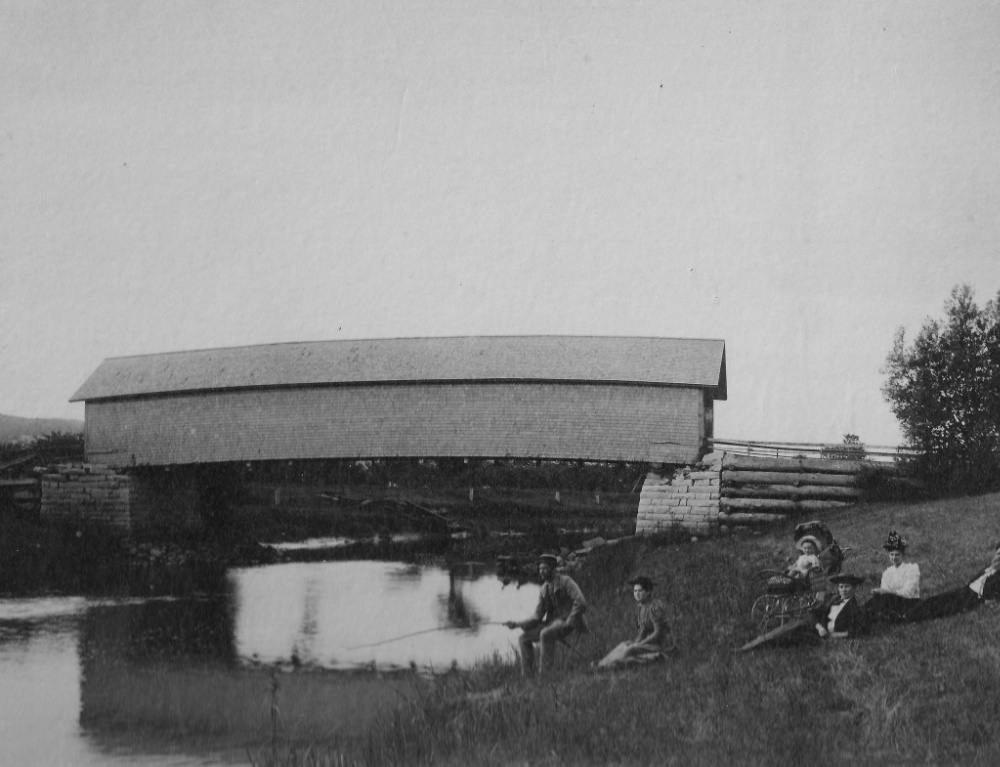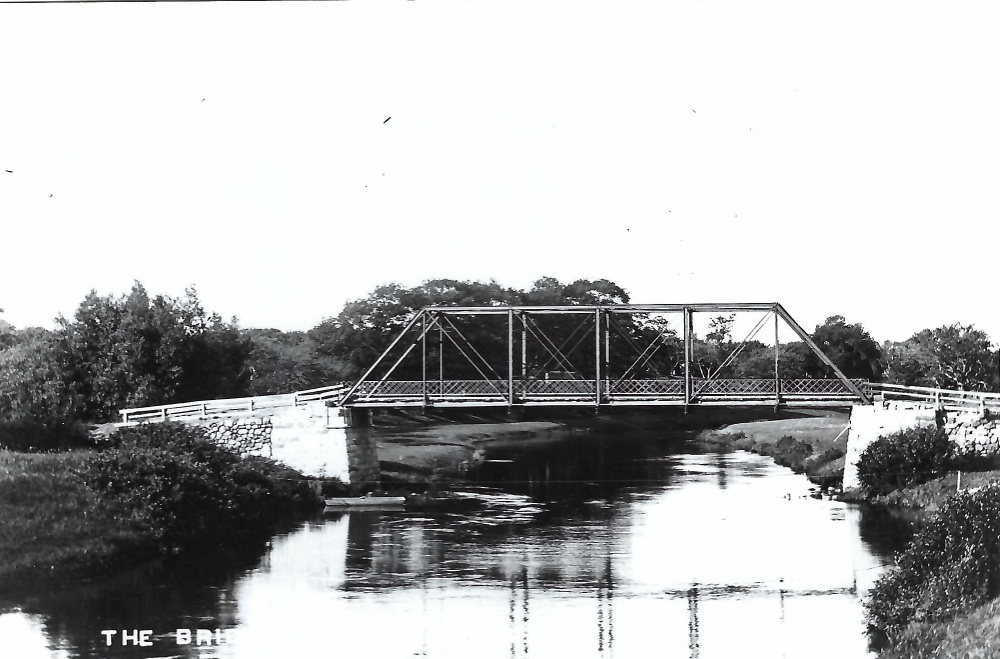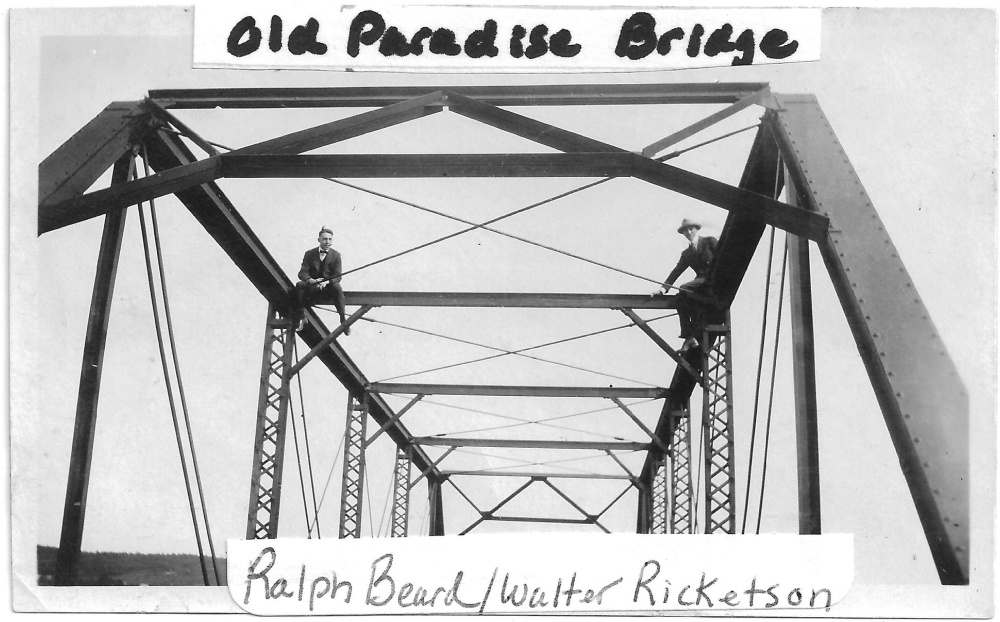The Bridges of Paradise
Never assume that the road or river or brook you see looks like the road or river or brook as it used to be. 225 years ago in Paradise, the landscape was different.
One change of the road in Paradise was the truncation of Leonard Road – the ancient route from North Mountain to the river. Once, this path, and later a road, ended at the “landing at the head of the tide.”
That part of the road was essential for the Mi’kmaq who travelled from the North Mountain to the river, for the Acadians who travelled up and down the river to sell products or visit friends and relatives, and for the Planter and Loyalist settlers who moved lumber and hay, merchandise and household goods, whatever needed moving, on “gondolas” or barges.
Landings were an essential part of transport on the river. So were the ferries which were simple barges that could transport people or goods across the river to connect settlements, or the two parallel roads that went to Annapolis. We see the landings mentioned in the 1799 military order from Headquarters – that when “expresses go from Headquarters to Annapolis they are to be put over the river…at Leonard’s by the party there.”

Old Mill Race near Paradise Lane
After some years of being “put over” on the ferry at this place, a petition went to the House of Assembly. It was time, the inhabitants said, for a bridge.
Their petition was composed and signed on June 26, 1801, by eleven men from both sides of the river, and submitted on behalf of “a number of the inhabitants of Wilmot [north side of the river] and “the upper part of the township of Annapolis” [the south side of the river] and “humbly sheweth that the great increase in the number of inhabitants of this County and that for the convenience of the province in general it is necessary that a bridge should be erected at or near the head of the tide over the Annapolis River.”
The advantages of such a bridge would be “plane to every disinterested person that is acquainted with the situation at the place at the present.” They note that there was no other way at that time to cross the river but by ferries which are “sometimes dangerous and at other times not profitable at all.” After careful examination by all the right people, they felt, three hundred pounds would be needed, though they sweetened the request by saying that they felt they could easily raise one hundred pounds by subscription, and had already raised most of it.
These petitions are interesting because we see the names and signatures of the people living in Paradise in the early 1800s.
For instance, the primary signator of this petition was William Bent, who would shortly after this petition purchase land or a house on the road extension, on the west side of it. The Bent family would live there for several generations. The impression of both the road and the Bent cellar where the family lived for several generations is still there beneath the overgrowth. Every spring drifts of snowdrops planted by one of the Bent women surface in the place that would have been a front or back yard.
The house is remembered in its own way. It was described in the 1890’s by a visitor who was quite enamored of Paradise. Elizabeth Mary Hunt-Morgan was on an evangelistic and fundraising tour and was hosted by the church in Paradise. She wrote: “We spent the earlier part of the evening with Mrs. Bent in her romantic little cottage in the midst of the universal apple-trees, beside a clear river rippling brightly on through sun and shade, carrying life and verdure everywhere with it.” She declared the whole village of Paradise to be “exquisitely beautiful.” ¹
Ten other men signed the petition in most elegant handwriting: Mr. Bent’s neighbour, Jonathan Leonard of Leonard’s Tavern, Andrew Marshall, Abiel Leonard, William Marshall, Charles Whitman, Calvin Marshall, Isaac Longley, Daniel Farnsworth, Richard Banks, and William Longley.
Their request for two hundred pounds for the bridge was approved, the note on the cover of the petition stating that there should be a plan for the most suitable place for a bridge to be erected over said Annapolis River between Clark’s Ferry and the house of Jonathan Leonard. I am unsure of the site of Clark’s Ferry. There were Clarks in Paradise, perhaps on the south side of the river?
The project never happened. Jonathan Leonard, whose property was somehow involved, died in 1802 and perhaps that was the spanner in the works. He died indebted, and it took time for probates to be approved and decisions to be made so that his wife Sarah and the children could continue to live there and operate the Tavern, as she did. So there is a gap, or silence, in the records.
But the idea of a bridge at the Landing was still in play and reborn in 1815 with even greater insistence. It was to be in the same spot, for the 1815 petition submitted by a new chief signator, Samuel Morse, and 48 or 49 other inhabitants proposed a bridge across the Annapolis River near the Head of the Tide at the east line of Isaac Marshall’s front property. That east line was actually the Leonard Road. It was to connect to a road offered by Edward Whitman on the south side.
In the end, of course, the bridge was built right where it is now, on Paradise Lane. Samuel Morse and his family owned the mills near the Lane. The business centre of Paradise had moved, and the bridge was needed elsewhere. Landings mattered less as roads were improved. The new route made sense; there was already a road on either side of the river on the Lane, and the river would be crossed on ice in winter or forded at low tide in summer.
The first bridge in Paradise was erected sometime after 1815, the date unknown. The second Paradise bridge was the lovely covered bridge seen in old postcards or family photos and was built in 1848. In 1907 we had our third bridge, a steel bridge that lasted until it met its nemesis- a heavy tractor-trailer. And finally, today we have a not-so-lovely but functional bridge that allows us to cross the Lane unless, of course, the spring floods prevent us.

The Second Bridge on Paradise Lane built in 1848.

Postcard of Paradise Lane Bridge (Origin and Date Unknown).

An iron bridge built in 1907.

Two young Paradise men climb on the old iron bridge.

View looking up the Annapolis River from the bridge on Paradise Lane in the summer of 2020.
It is still a pleasure to stand at the bridge and watch the river that flows, day after day, as it did for William Bent and Samuel Morse and all the others.
There is a sign over a bridge on Queen Street in Toronto that says, “The river I step in is not the river I stand in.” The river flows, as does the history of all places and people.
Written by Barbara Bishop
